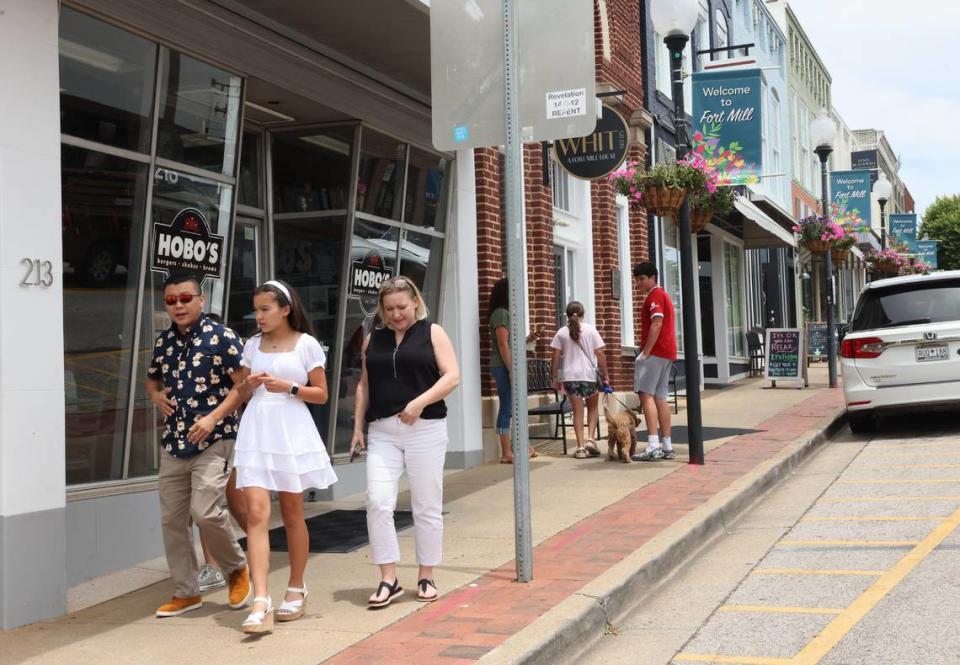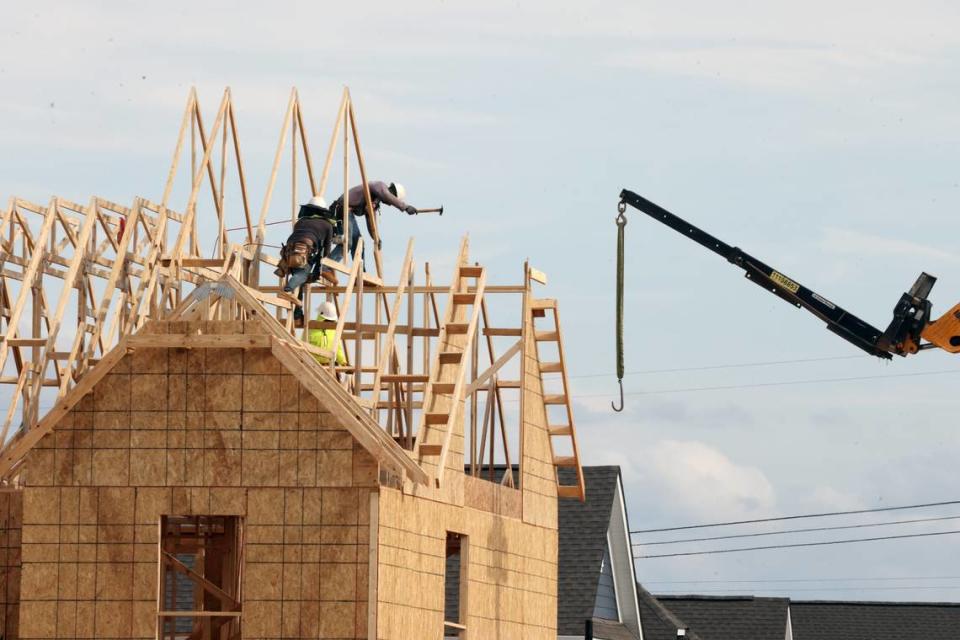What’s driving Fort Mill’s rapid growth? A little ‘Mayberry’, a lot of construction
Just off the Catawba River on the South Carolina side, a bustling piece of property near the birthplace of Fort Mill offers up a chorus of construction traffic by day and laughing children by evening.
Parents and grandparents watch pickup soccer at a pocket park. And new homeowners on dog walks meet neighbors from other states, or from across the globe.
They are part of the Elizabeth subdivision, which Fort Mill approved in 2016. By the time the first residents moved in last year, plans had evolved to cover about 1,300 homes and townhomes, plus a few hundred apartments.
Here's our latest accountability reporting
Reality Check reflects the Charlotte Observer’s commitment to holding those in power accountable. Here are three of our stories from this week:
→ Should Charlotte pay for renovations at Bank of America Stadium? ‘Tough’ call, says expert
→ Death Row exoneree has waited on 3 NC governors to say he was innocent, pardon him
→ CMS graduation rate is dropping while other NC districts rise. But officials aren’t worried?
“I never found a person that lives in Fort Mill and doesn’t like it,” said Victoria Tibernii, who left Vermont for a short stop in Charlotte before moving to Fort Mill in York County. “Everyone seems to love Fort Mill. This town has good schools, good restaurants, feels safe and is very family-friendly.”
And Fort Mill’s appeal seems to be growing, based on the latest U.S. Census Bureau estimates.
Among all municipalities with 20,000 or more people, Fort Mill’s growth rate ranked No. 13 in the country with 8.8% growth from 2022 to last year. Its 37.2% growth from 2020 to last year ranked No. 7 nationally for communities that size.
Most of the Charlotte metro grew too. Charlotte added the third most residents of any city since 2022. Yet increasingly, Fort Mill is the poster child for a ribbon of growth that keeps getting bigger.
FORT MILL GROWTH SURGE: Its growth rate tops nearly all big US cities and towns
The result is a place where schools and roads are crowded, but also one where residents routinely pass tens of millions of dollars worth of school bonds and sales taxes to fund them. Where big-city Charlotte pushes against the small-town feel that attracted people, but also offers jobs and entertainment.
Fort Mill is a town in the throes of change.
”We have one goal in common,” said Fort Mill Town Councilman Chris Moody. “To make Fort Mill the greatest place to live in the state of South Carolina.”

Seeing Fort Mill as a ‘welcoming town’
Moody grew up in rural Dillon County, about halfway to Myrtle Beach from Fort Mill, but knew from a young age he wanted to leave the farm.
He graduated from North Greenville University and moved more than 100 miles northwest to Fort Mill 23 years ago. “I thought Fort Mill was a city around the size of Florence or Rock Hill,” said Moody, first elected to council in 2015. “When I drove down Main Street for the first time, most of the buildings were unoccupied.”
He found a pizza place, a barber shop and a knife shop open.
Fort Mill Barber Shop is still open — it’s been there since 1910 — but there’s storefront after storefront of local restaurants, retail shops and breweries surrounding it in downtown. Towns across the state would be glad to have Fort Mill’s Main Street, Moody said.

“Fort Mill is a welcoming town, and I would compare it to Mayberry,” he said of the fictional North Carolina town from the “Andy Griffith Show.” “To be a suburb of Charlotte, it does still have a small-town feel.”
‘Connection, community and a great haircut’: Fort Mill barber shop tradition continues
It’s a challenge to keep that feel, however.
Last fall, the town denied an annexation near White Grove that would’ve added 500 homes. Two years ago, Moody and council voted down about 350 homes on South Dobys Bridge Road, and 60 homes near Waterside at the Catawba.
Reasons ranged from failing traffic grades to impact on existing residents. The town set up development impact fees to make home developers pay some of the costs for new parks and municipal buildings.
In May Fort Mill committed almost $30 million to buy two former mill office buildings downtown. A growing town staff and police department needed the larger space.
Fort Mill to purchase iconic Springs Industries building for new town hall location
A steady flow of new people into Fort Mill means plenty of conversation on how they got there.
The school district is the biggest driving force, Moody said. New constituents tell him they left a city so their children could attend, or like him they came from a smaller area for educational opportunities.
“Having a good school system is a catalyst for economic growth,” Moody said. “If you look at the pattern of many smaller, rural towns across South Carolina, there is a direct correlation between struggling school systems and anemic economic growth.”
The growth also brought large corporations like LPL Financial, Lash Group and Domtar in the Kingsley area.
“Many individuals in the smaller rural towns in our state must leave home, like I had to do, in order to find a good job,” Moody said. “That is not the case in Fort Mill.”
Fort Mill is also a Republican stronghold with about 72% white residents, 12% Black residents, nearly 7% Hispanic and 5% Asian. Owners of a typical Fort Mill home bring in about $128,000 a year, about double the South Carolina median household income.
The median age of 36.7 is almost four years younger than South Carolina as a whole. And in a town known for its school system, 32.5% of all residents are 19 or younger.

Decades of Charlotte metro growth
Forty years ago, Fort Mill was a speck on the map when compared to growth around the Charlotte region. In 1980, Mecklenburg and the seven counties that border it had a little more than 1 million residents. Now they have 2.6 million.
How those metro counties grew in recent decades varies.
From 1982 to 1991, Mecklenburg had the highest or second highest annual growth rate. In the 1990s, Union County exploded. Starting in 1991 it led regional growth for 18 straight years, peaking at 9.1% in 2000, and also was one of the nation’s fastest growing counties too.
Then South Carolina began its surge.
Lancaster County finally pried the top spot away from Union County in 2009. Since then, Lancaster County led the metro area’s growth rate nine times including the past three years. York County led twice.
Municipal growth followed similar lines.
Marvin, Waxhaw and Indian Trail in Union County led the region each year from 2001 to 2010, as people sought lower taxes, better schools and didn’t mind commuting to uptown or other parts of Charlotte.
After Tega Cay spent four years as the highest-growth municipality outside Union County, Fort Mill took the top overall spot in 2011 with an 8.9% growth rate. In fact, Fort Mill claimed the highest growth in the region seven of the last eight years.
Since 2011, the average annual growth rate in Fort Mill is 9.2%. Waxhaw is next highest at 6.8%, followed by Tega Cay at 4.8%. The average across the 29 largest cities and towns in the Charlotte area is 2.3% annual growth.
Why else is Fort Mill growing so much?
Bob Coats is the Governor’s Census Liaison in the North Carolina Office of State Budget and Management. He studies trends that go beyond good schools and lower taxes for why people move.
“You’ve got a number of factors that are changing communities in the nation,” Coats said.
The southward migration that began in the 1970s from northeastern manufacturing hubs continues to impact areas like Charlotte, where banking and other jobs draw growth, he said. Yet the national birth rate is low and Baby Boomers are aging.
The result is a metro area still adding to its population, but not at the rate it was two decades ago.
The COVID pandemic also impacted where people choose to live, factoring in variables like higher home costs and remote work options. “We’re a more mobile population,” Coats said. “Folks are realizing it’s a little cheaper to live outside of Mecklenburg County.”
High-growth areas tend to be places where the housing mix matches the geography, Coats said.
Places along lakes or rivers, for instance, might draw more retirees while athletic fields and parks are important in attracting younger families.
Often young workers migrate closer to city centers but then spread out as they age. “When they get to the age of wanting to start families, they may be wanting a little more yard space,” Coats said.
Charlotte sprawl grew closer to Fort Mill. Ballantyne grew right up to Indian Land’s doorstep. The closer the services and new neighbors came, the more attractive the panhandle became.
It’s similar to how York and Clover in western York County are seeing more homes now after years of Fort Mill, Lake Wylie and Tega Cay filling up. “Once those subdivisions are in place, then you’ve got to look for new land to develop,” Coats said.
For South Carolina communities, it’s a “pretty soft border” in terms of anything that might keep Charlotte growth from spilling across the state line.
“It’s not a geographic factor as much as it is, how is the growth of this area or this county being impacted by this larger city?” Coats said. “That border doesn’t really come into play.”

Fort Mill’s growth challenges
More people means a need for more police, firefighters and utility workers. Growth means new and bigger schools. It also brings traffic and other headaches.
Moody wonders if folks consider the alternative to living where so many people want to call home. He explains to his children why buildings are boarded up and parks have cinderblocks for bleachers when they travel through parts of South Carolina that aren’t growing.
“People in Fort Mill should be thankful for what they have,” Moody said. “Because there are a lot of have-nots. There are a lot of people that want what we have.”
Fort Mill and Tega Cay voters passed a $204 million school bond referendum in March. It was the ninth one approved for new school construction since 1992, for a combined $915 million for the Fort Mill School District.

The district says the recent bonds can’t cover all of its growth needs. More bonds will follow.
If Fort Mill and Clover schools grow the same way, why does one get so much more cash?
Another complaint elected officials routinely get is how the residential growth impacts traffic.
The Rock Hill-Fort Mill Area Transportation Study allocates federal transportation money to urbanized York and Lancaster counties. Last fall, the group opted to grow Fort Mill’s representation on its policy committee, sparked not only by population gain but also the hub role Fort Mill plays in the region.
The most obvious routes between the region’s population giants, Charlotte and Rock Hill, run through Fort Mill. So do trips from Tega Cay, Lake Wylie or Steele Creek to Indian Land or Ballantyne.
There aren’t many routes that avoid the town.
“Fort Mill, whether it wants it or not, is going to have through traffic traveling through its jurisdiction,” transportation group director David Hooper said in the fall. “It’s a daily reality.”

Indian Land, Lake Wylie, Baxter and Carowinds
Fort Mill hasn’t snatched the growth torch from Union County alone.
Indian Land, Lake Wylie and unincorporated York County between Fort Mill and Tega Cay have seen similar population upswings. Expensive new homes, traffic, massive school bonds and pressure on public services have been their story for a decade or more, too.
It’s a connected band of growth that follows the Catawba River and state line just beyond the southwest reach of Charlotte.
Lancaster County has some large residential projects like Roselyn and Riverchase south of its panhandle, but until recent months, growth was almost entirely north of S.C. 5.
From 1980 to 1996, Lancaster County averaged less than 0.4% annual growth. Since then, there’s been an average 2.4% annual growth rate. The county topped 4% four times.
That growth coincides with the formation of Ballantyne, the massive mixed-use development that connects Charlotte to South Carolina along the U.S. 521 corridor.
If the Indian Land panhandle were a city, it would be top 10 in South Carolina for population.
Lancaster County had the lowest growth rate among the Charlotte metro counties nine times from 1982 to 1992. In all but three years since 2007, Lancaster County has been a top-two growth county in the region.
Areas like Baxter and Carowinds in York County also have been major growth drivers with the same strong schools, South Carolina taxes and proximity to Charlotte.
From 2001 to 2019, unincorporated York County grew by an average of 2.9%. That’s higher than the 2% average among all metro counties combined in that same span.

‘Community and belonging’ in Fort Mill
Back in the Elizabeth neighborhood of Fort Mill, more than 180 homes sold in less than two years. What started in the $300,000 range is now in the $400,000s and up, to almost $700,000. Those homes brought families from India, New Jersey, Charlotte and many other places.
Sarah Barkley grew up here, teaches in Fort Mill schools and moved back from Indian Land to Elizabeth. Fort Mill is close enough to Charlotte to enjoy what it offers, she said, but the schools and small-town feel make Fort Mill home.

Other neighbors hadn’t heard of Fort Mill until family, when folks from church or friends suggested it. For Tibernii, the former Vermonter, it all started with a conversation among friends about where she wanted to be.
“Although Charlotte is a beautiful city, I was missing the sense of community and belonging,” she said.
Tibernii, like so many others in recent years, found it in Fort Mill.
Reality Check reflects the Rock Hill Herald’s commitment to holding those in power to account, shining a light on public issues that affect our local readers and illuminating the stories that sets the Rock Hill region apart. Email realitycheck@heraldonline.com


